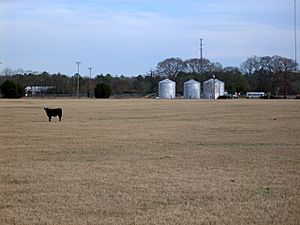Tar Heel, North Carolina facts for kids
Quick facts for kids
Tar Heel, North Carolina
|
|
|---|---|

A pasture on the edge of Tar Heel
|
|

Location in Bladen County and the state of North Carolina.
|
|
| Country | United States |
| State | North Carolina |
| County | Bladen |
| Government | |
| • Type | Mayor–council government |
| Area | |
| • Total | 0.23 sq mi (0.60 km2) |
| • Land | 0.23 sq mi (0.60 km2) |
| • Water | 0.00 sq mi (0.00 km2) |
| Elevation | 131 ft (40 m) |
| Population
(2020)
|
|
| • Total | 90 |
| • Density | 387.93/sq mi (149.87/km2) |
| Time zone | UTC-5 (Eastern (EST)) |
| • Summer (DST) | UTC-4 (EDT) |
| ZIP code |
28392
|
| Area codes | 910, 472 |
| FIPS code | 37-66740 |
| GNIS feature ID | 2406713 |
Tar Heel is a small town in Bladen County, North Carolina, United States. In 2020, about 90 people lived there.
This town is special because it's home to the world's largest pig processing plant. This big factory, run by Smithfield Foods, opened in 1992 and is just outside the town.
Contents
Exploring Tar Heel's Location
Tar Heel is located right next to the Cape Fear River. This river has been important for the town's history.
You can reach Tar Heel using major roads like NC 87 and NC 131. Nearby cities include Fayetteville (about 25 miles north), Elizabethtown (about 15 miles southeast), and Lumberton (about 16 miles southwest).
The town covers a small area of about 0.4 square kilometers (0.23 square miles), and it's all land.
A Look at Tar Heel's History
The community of Tar Heel has a long history, going back to the American Revolutionary War. A famous person from that time, Colonel Thomas Robeson, lived here. Robeson County was even named after him! His old home, called Walnut Grove, is still standing and is listed in the National Register of Historic Places.
During the American Civil War, local leaders like Colonel Thomas Purdie and Captain Daniel Munn led troops in important battles such as Gettysburg and Fort Fisher.
The town of Tar Heel officially became a town in 1963, when the State of North Carolina recognized it.
How Tar Heel Got Its Name
Tar Heel was once a very important place for shipping goods on the Cape Fear River. There was a state-run ferry here, and many boats would load up farm products to take to the market in Wilmington.
A main product shipped from here was barrels of turpentine. Tar Heel had several places where turpentine was made. When these barrels were moved, they often leaked. This caused a sticky, tar-like material to build up around the river landing. People would say they were "going to get tar on their heels" when they visited the village. This is how the town got its unique name!
It's good to know that Tar Heel is different from Chapel Hill, North Carolina, which is home to the University of North Carolina Tar Heels sports teams.
Two historic places in the area, the Purdie House and Purdie Methodist Church and Walnut Grove, are listed on the National Register of Historic Places.
Community Services in Tar Heel
Even though it's a small town, Tar Heel provides important services for its residents:
- Street maintenance, trash pickup, and street lights help keep the town clean and safe.
- The Bladen County Sheriff's Office provides police protection.
- The Tar Heel Rural Volunteer Fire Department helps keep everyone safe from fires.
- Water services are provided by the Tar Heel Water Corporation.
Schools in the Tar Heel Area
Public schools in the Tar Heel area are part of the Bladen County School system:
- Plain View Elementary School
- Tar Heel Middle School
- Tar Heel High School (This school joined with Bladenboro High School in 2001. The original Tar Heel High School building was built around 1909.)
Churches in the Community
The Tar Heel community is home to several churches:
- Love Grove Baptist Church
- Tar Heel Baptist Church
- Tar Heel Free Will Church
- Beth Car Presbyterian (This church is listed as a historic site.)
- Clark's Chapel
- New Life Ministry
- Purdie's Methodist (This is the oldest Methodist Church in North Carolina that hasn't been changed much. It's also on the National Register of Historic Places listings in Bladen County, North Carolina.)
People of Tar Heel
| Historical population | |||
|---|---|---|---|
| Census | Pop. | %± | |
| 1970 | 87 | — | |
| 1980 | 118 | 35.6% | |
| 1990 | 115 | −2.5% | |
| 2000 | 70 | −39.1% | |
| 2010 | 117 | 67.1% | |
| 2020 | 90 | −23.1% | |
| U.S. Decennial Census | |||
In 2010, there were 117 people living in Tar Heel. Most of the people were White (about 93%). A small number of residents were Mexican or Native American.
See also
 In Spanish: Tar Heel (Carolina del Norte) para niños
In Spanish: Tar Heel (Carolina del Norte) para niños

